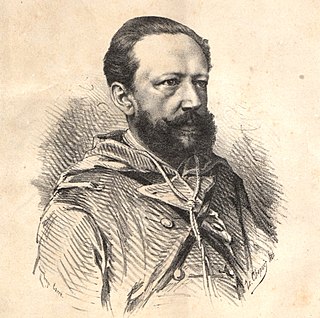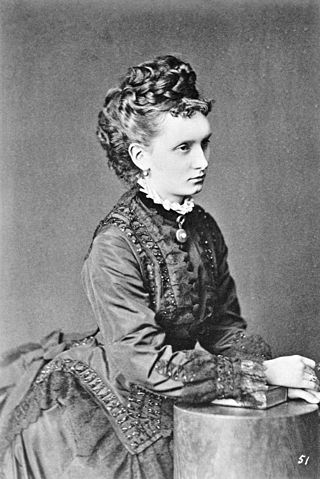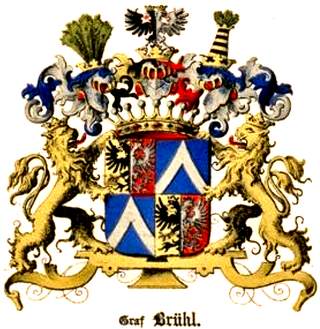History
The first known ancestor of the Hauke family was Johann Gaspar Hauck, a registrar at the Imperial Chamber Court of the Holy Roman Empire in Wetzlar, who died in 1722 and was buried in his home town. By his wife Johanna Barbara Mederacke, he had ten children, of whom two sons, Johann Valentin (1698–1722) and Ignatz Marianus (1706–1784), came to important positions: Johann continued the family tradition of employment at the Court of Justice in Wetzlar, while Ignatz became a secretary to the Government of the Electorate of Mainz.
Ignatz, too, had many children, nine, with his wife Maria Franziska Riedesel zu Eisenbach (1717–1785), who was an illegitimate (later acknowledged) daughter of Baron Georg XX Riedesel zu Eisenbach (1690–1737), a member of one of the oldest Hessian noble families. One of their sons, Johann Friedrich Michael Hauck (born 1737 in Mainz, died 1810 in Warsaw) moved to Saxony and later to Poland as a secretary of the powerful Count Alois Friedrich von Brühl, Starost of Warsaw, General of the Royal Polish Artillery and son of Heinrich von Brühl, the famous Saxon-Polish minister.
In 1782, Count Alois von Brühl sold his Polish dignities and estates and returned to Saxony, but Johann Friedrich stayed in Warsaw with his family of seven children by an Alsatian Protestant preacher's daughter, Maria Salomé Schweppenhäuser (1755–1833). Having changed his Christian names to the more Polish sounding Fryderyk Karol Emanuel and his surname to Hauke, Fryderyk Karol Emanuel Hauke had considerable success as owner of a private school and later as teacher of the German language and mathematics at an exclusive Prussian school for boys, called Warsaw Lycaeum.
Three of Fryderyk Karol Emanuel Hauke's sons, John Maurice, Ludwik August (1779–1851) and Joseph (1790–1837), entered after 1815 the service of the Czar, who was at the same time King of Congress Poland, achieved very high positions and received titles and rights od Polish nobility in 1826. The coat of arms awarded to them received in accordance to the Polish custom of naming arms the name "Bosak" (Grappling hook), which one member of the family, Joseph, later used as a pseudonym. John Maurice (in 1829) and Joseph (in 1830), both of them Generals, were elevated to the rank of counts of the Russian Empire. In 1861, the branch of Ludwik August followed, having obtained an Austrian confirmation of the title of Count awarded to General Alexander Hauke (1814–1868), who married his cousin Sophie (1816–1861), a daughter of Count John Maurice and sister to Countess Julia and Countess Catharina, mistress of Grand Duke Paul Frederick of Mecklenburg-Schwerin.
In 1851, Julia, who had been serving as a lady-in-waiting to Princess Wilhelmine Marie of Hesse and by Rhine, married the princess's brother, Prince Alexander of Hesse and by Rhine. The marriage was deemed morganatic, as Julia was not of royal lineage, and her children were disqualified from the line of succession to the throne of the Grand Duchy of Hesse. The year of her marriage, Julia's brother-in-law, Louis III, Grand Duke of Hesse, made her the Countess of Battenberg in her own right with the style of Illustrious Highness . In 1858, she was elevated to the style of Serene Highness with the title Princess of Battenberg, in her own right. Her children became members of the House of Battenberg, a morganatic branch of the House of Hesse-Darmstadt.
The branches of John Maurice and Joseph became extinct in male line in 1852 respectively in 1949, the branch of Ludwik and Alexander still flourishes. Its descendants all live in Stockholm except one, who is a Dominican prior in Poznań. They left Poland and settled in Sweden about 1960, aided by their relative, Queen Louise of Sweden.
Most of the Haukes living in Warsaw in the first half of the 19th century are buried at the Catholic Powązki Cemetery in Warsaw, those who were Lutherans or Calvinists (mostly Protestant women who married into the family) repose at the Lutheran and Calvinist Cemeteries of the Polish capital. Solely John Maurice and his wife lie in the crypt of the Capucin church in Warsaw's Old Town.

The Baron Friedrich Adolf Riedesel zu Eisenbach was a senior officer of Brunswick–Luneburg troops who commanded jägers in the Northern theater of the American War of Independence.

Julia, Princess of Battenberg, previously Countess Julia von Hauke and Countess of Battenberg, was the wife of Prince Alexander of Hesse and by Rhine, the third son of Louis II, Grand Duke of Hesse.

Prince Henry of Battenberg, formerly Count Henry of Battenberg, was a morganatic descendant of the Grand Ducal House of Hesse. He became a member of the British royal family by marriage to Princess Beatrice of the United Kingdom, the youngest child of Queen Victoria. Through his daughter, Victoria Eugenie, who became the queen consort of Spain, Henry is a direct ancestor of the current Spanish royal family.

The Mountbatten family is a British family that originated as a branch of the German princely Battenberg family. The name was adopted by members of the Battenberg family residing in the United Kingdom on 14 July 1917, three days before the British royal family changed its name from Saxe-Coburg and Gotha to Windsor. This was due to rising anti-German sentiment among the British public during World War I. The name is a direct Anglicisation of the German name Battenberg, which refers to a small town in Hesse. The Battenberg family was a morganatic line of the House of Hesse-Darmstadt, itself a cadet branch of the House of Hesse.

The Battenberg family is a non-dynastic cadet branch of the House of Hesse-Darmstadt, which ruled the Grand Duchy of Hesse until 1918. The first member was Countess Julia von Hauke, whose brother-in-law Grand Duke Louis III of Hesse created her Countess of Battenberg in 1851, along with the style of Illustrious Highness (H.Ill.H.), at the time of her morganatic marriage to Grand Duke Louis's brother Prince Alexander of Hesse and by Rhine. The name of the title refers to the town of Battenberg in Hesse. In 1858, the countess' title was elevated to Princess of Battenberg, with the style of Serene Highness (H.S.H.).

Count Hans Moritz von Hauke was a Polish general and professional soldier of German extraction. He was a member of the Hauke-Bosak family.

The Czartoryski coat of arms is a Polish–Lithuanian coat of arms, a variant of the Pogoń Litewska arms. It has been used by the Gediminid Czartoryski family.

Battenberg is a small town in the district of Waldeck-Frankenberg in the state of Hesse, Germany. It is located on the river Eder, a tributary of the Fulda, which flows into the Weser, and lies at the southeastern edges of the Rothaar Mountains. The closest larger cities are Marburg, Siegen, and Kassel, and the town is approximately equally far away from Frankfurt am Main, Cologne, and Dortmund.

Count Józef Hauke-Bosak was a Polish general in the January Uprising, and commander of the Polish army in Lesser Poland, the closest collaborator of rebellion leader Romuald Traugutt. He fought many successful battles against the Russians in this region. He fled Poland after the Uprising collapsed in 1864. He died in the post of commander of brigade in the French army at Vosges, during the Franco-Prussian war in 1871.

Prince Alexander of Hesse and by Rhine, was the third son and fourth child of Louis II, Grand Duke of Hesse, and Wilhelmine of Baden. He was a brother of Tsarina Maria Alexandrovna, wife of Tsar Alexander II of Russia. The Battenberg-Mountbatten family descends from Alexander and his wife Countess Julia von Hauke, a former lady-in-waiting to his sister.

Prince Maurice of Battenberg was a member of the Hessian princely Battenberg family and the extended British royal family, and the youngest grandchild of Queen Victoria. He was known as Prince Maurice throughout his life, since he died before the British royal family relinquished their German titles during World War I and the Battenbergs changed their name to Mountbatten.

Alois Friedrich von Brühl was a Saxon-born diplomat, politician, Freemason, soldier, actor and playwright in the Polish–Lithuanian Commonwealth.
Hauke, pronounced[ˈhɔukə], is a fairly common Frisian masculine given name. According to onomatologist Rienk de Haan, this name developed from a reduced form of Germanic names starting with either Habuk- or with Hug-. If the last etymology is correct, Hauke would be the Frisian version of Hugo.

Georg Detlev von Flemming was a General in Polish-Saxon service, Grand Treasurer of Lithuania in 1746–1764 and Voivode of Pomerelia in 1766.

Princess Marie of Battenberg was a Princess of Battenberg and, by marriage, the Princess of Erbach-Schönberg. She worked as a writer and translator.

Franz Anton Leopold Lafontaine was a German-born Polish military surgeon. He was known as the editor of the first Polish medical journal and for his work on catarrh.

The Brühl family is an old German noble family from Saxony-Thuringia, with their ancestral seat in Gangloffsömmern in Thuringia. Branches of the family still exist today.

Maria Salomé Schweppenhäuser, 29 November 1755 – Warsaw, 5 September 1833), daughter of Heinrich Wilhelm Schweppenhäuser, a Protestant priest from Oberotterbach, and his wife, Charlotte Philippine, née Westermann, was a court chambermaid at Bad Bergzabern and Darmstadt. She was the wife of Friedrich Karl Emanuel Hauke (1737–1810), and, as such, an ancestor of the Battenberg/Mountbatten family, descended from her paternal granddaughter Julia Hauke and Prince Alexander of Hesse and by Rhine. After the death of her father, Maria Salomé was a chambermaid at the court of Bad Bergzabern, the seat of the widowed Countess Palatine Caroline of Zweibrücken. She was later employed at the court of Darmstadt by Caroline's daughter, Princess Caroline, wife of Louis, Hereditary Prince of Hesse-Darmstadt. In 1773 Maria Salomea married Friedrich Hauke, secretary of the Count of Brühl. Brühl was summoned to Warsaw in 1782, and Friedrich Hauke became a tax collector in Poland. Friedrich and Maria Salomé's son, Johann Moritz Hauke, was a general of the Russian troops in Poland from 1816 and was elevated to Count Hauke in 1829, but was murdered in 1830, during an uprising in Warsaw, and his children went to live with their grandmother at the court of Nicholas I of Russia in Saint Petersburg. His daughter Julia married morganatically Prince Alexander of Hesse and by Rhine in 1851. Prince Alexander's older brother the Grand Duke created Julia "Countess" and later "Princess of Battenberg", a title passing on to all of their descendants, although renounced by some.

Friedrich Karl Emanuel Hauke was the son of Ignatius Hauke (1705–1784) and Maria Franziska (1718–1785), an illegitimate daughter of Baron Georg Riedesel zu Eisenbach. Friedrich is a direct ancestor of the British and Spanish royal families. Three of his sons were elevated to the rank of count within Poland–Lithuania and the Holy Roman Empire.



















